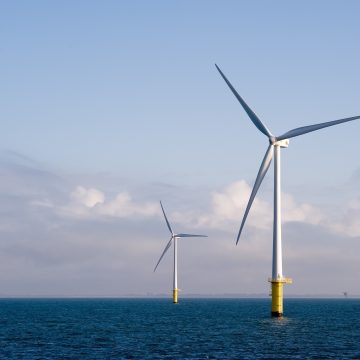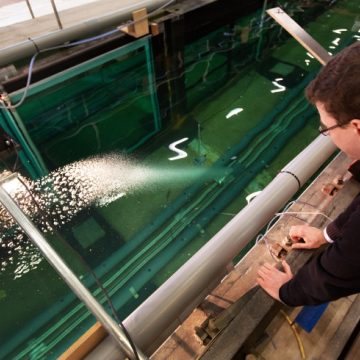Sustainable decommissioning of offshore wind turbine foundations
The current lifetime of offshore wind farms in the North Sea is, in general, limited to 25 years. At the end of its life, turbine owners have the responsibility to completely decommission the wind turbine structure, including its monopile foundation. In this project, hydraulic pile extraction, which allows for the complete removal of the monopile in a sustainable way, is tested and studied.

Hydraulic pile extraction
Monopiles are the most used foundation type for wind turbines, consisting of a single, open-ended steel pile weighing up to 1500 tons. Current decommissioning practice is to cut off the pile and leave behind tons of high-quality steel in the seabed. Hydraulic pile extraction is an innovative method which can be used for the removal of the monopile foundation of offshore wind turbines.
In practice, it requires two steps:
- Sealing the pile: the process begins by sealing the top of the monopile and any holes in the pile wall after removal of the turbine structure.
- Pressurising with water: The sealed monopile is filled with seawater, which is pressurised using a high-pressure pump. The hydraulic force acts on the pile lid and forces the monopile to move upward, effectively extracting it from the seabed. A crane then lifts the pile onto a vessel for transport onshore.
The main challenge in this process is to predict the Break-Out Pressure (BOP) needed to overcome the pile weight plus the friction forces between soil and pile wall and to initiate upward movement. In a practical situation the BOP will define requirements for the pumping system and other operations.
Video
In this sped-up video, you witness the extraction of a pile as a result of the hydraulic force applied inside the pile. Pile dimensions: 1.5 meter in diameter and 7.5 meter in length (5.5 meter embedded in the soil). The time required for the complete extraction was less than 30 minutes.
You have not yet indicated whether you want to accept or reject cookies. This means that this element cannot be displayed.
Or go directly to:
Tests at intermediate scale
The Hydraulic Pile Extraction Scale Test project (HyPE-ST1.2) proved the hydraulic extraction technique at an intermediate (1:5) scale. The tests were performed in the 10 meter deep test pit of the Test Centre for Support Structures in Hannover. Using an impact hammer, 3 piles with a diameter of 1.5 meter were installed in the test pit.
Each pile contained a dedicated set of sensors at different depths to measure water pressure and total pressure on the pile wall and the strains along the steel foundation. In addition, the hydraulic pressure, the water flow and movement of the pile were recorded.
One of the extracted piles was outfitted with a hole in order to test a device which can be used to close off cable inlet holes on the inside of the pile. The device performed flawlessly under high pressure.
Griffin Stuip, Senior Structural Engineer at KCI,
Project results
We performed successful hydraulic extraction tests on small and intermediate scale. This enhanced our understanding of pile-soil interaction and demonstrated the proof of concept in representative soil conditions. Key output of the project is the BOP prediction model, validated at intermediate scale. This allows for prediction of the BOP for different configurations. With that the principle of the technology is ready for a first full-scale application.
A wide application of the hydraulic extraction technology enables the following results:
- All steel is recovered and can be re-used or recycled.
- The impact of hydraulic extraction to marine life is very low.
- The challenging and costly subsea cutting operation below the sea floor can be avoided.
The HyPE-ST project is part of the GROW program and a joint industry initiative of Deltares, DOT, IQIP, Jan de Nul, KCI, SIF, RWE and TNO. The project receives financial support from the Dutch Ministry of Economic Affairs.
Video
In this video the hydraulic extraction method is explained and the proof-of-concept is tested at small scale in the Deltares Soil Water flume.
You have not yet indicated whether you want to accept or reject cookies. This means that this element cannot be displayed.
Or go directly to:




